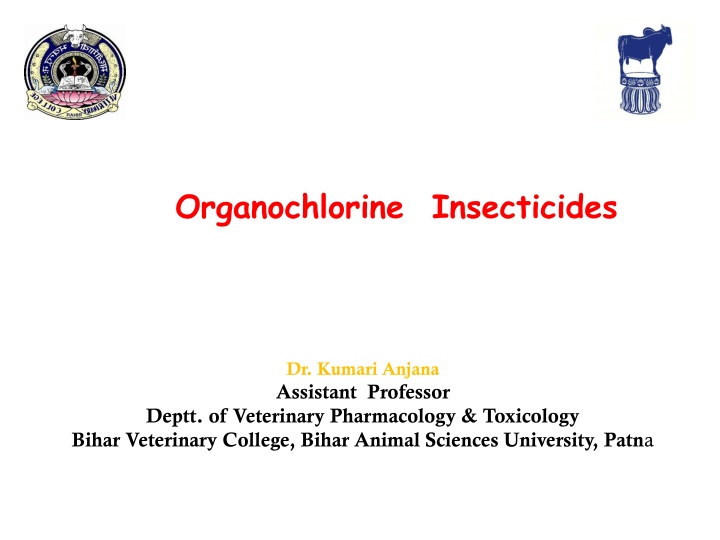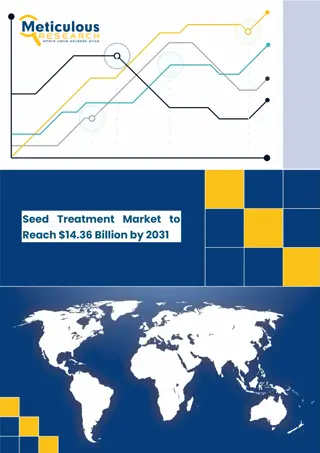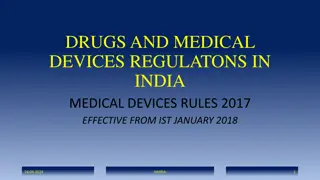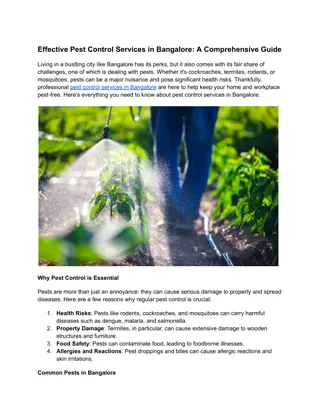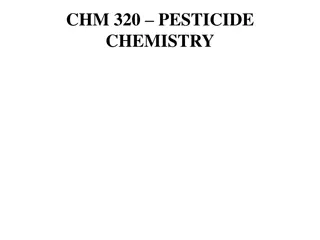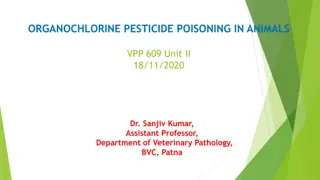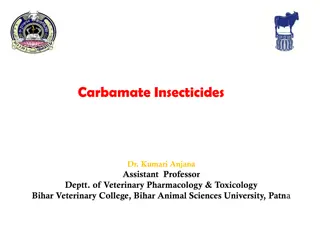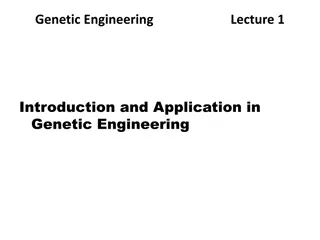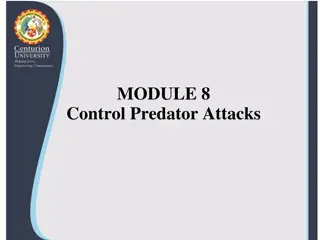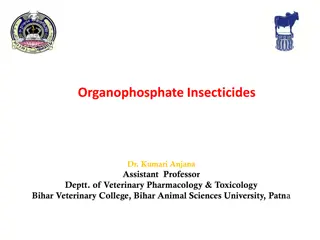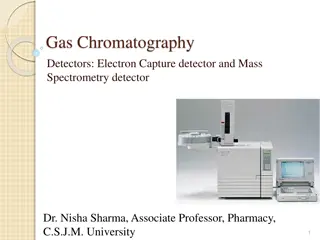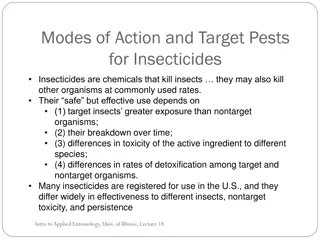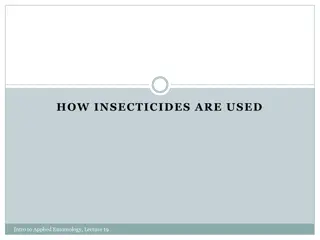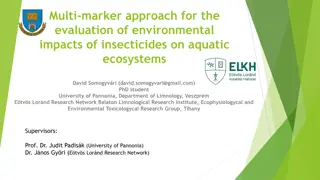Introduction to Organochlorine Insecticides
Organochlorine insecticides are a key part of pest control in agriculture, but their use has raised concerns due to their toxicological impact on both the environment and living organisms. This chapter covers the classification, sources of poisoning, factors affecting toxicity, mechanisms of toxicity, clinical symptoms, lesions, diagnosis, and treatment of organochlorine compounds. Learn about their impact on crops, pests, and the ecosystem.
Download Presentation

Please find below an Image/Link to download the presentation.
The content on the website is provided AS IS for your information and personal use only. It may not be sold, licensed, or shared on other websites without obtaining consent from the author.If you encounter any issues during the download, it is possible that the publisher has removed the file from their server.
You are allowed to download the files provided on this website for personal or commercial use, subject to the condition that they are used lawfully. All files are the property of their respective owners.
The content on the website is provided AS IS for your information and personal use only. It may not be sold, licensed, or shared on other websites without obtaining consent from the author.
E N D
Presentation Transcript
Organochlorine Insecticides Dr. Kumari Anjana Assistant Professor Deptt. of Veterinary Pharmacology & Toxicology Bihar Veterinary College, Bihar Animal Sciences University, Patna
Contents of the chapter Introduction to Agrochemicals Introduction to Pesticides Pesticides Classification Introduction to Insecticides Insecticides Classification Organochlorine compounds Sources of poisoning Classification of OCI Factors affecting toxicity Mechanism of Toxicity Clinical symptoms PM Lesions Diagnosis Treatment
Agrochemicals Agrochemicals are of two major groups: Fertilizers Pesticides Nitrate, Phosphorus and Urea are used as fertilizers. A pest is an uneconomical, undesirable or harmful species that adversely affect the economic, desirable or beneficial species. Pesticides are used to kill the pests.
Pesticides Pesticides:are heterogeneous groups of substances used for preventing, destroying or repelling pests. Pesticides are the most widely used agrochemicals of toxicological importance. Use economical control of pests or increase production of crops
Pesticides Classification Insecticides Organochlorines Diphenyl aliphatic agents Chlorinated cyclodienes Arylhydrocarbons Organophosphates Phosphate Phosphonate Phosphorothionate Phosphorothiolate Carbamates Carbaryl propoxur Pyrethrins and pyrethroids Natural pyrethrins Synthetic pyrethroids Herbicides or weedicides Dinitrocompounds Phenoxyacetic acids Bipyridium compounds Triazenes Rodenticides Inorganic agents Dicumarol derivatives Glycosides Fungicides Zineb Captan Fumigants Ethelene dibromide
Insecticides Substances which are specifically used for preventing, destroying or repelling the insects pests. The use of insecticides in agriculture has grown tremendously since world war II. Now a days insecticides have become an integral part of agriculture. Large scale use- acute toxicities, residues in food stuff and environmental problem.
Insecticides Organochlorines- DDT, BHC Organophosphates- malathion, sarin Carbamates- Carbaryl, propoxur Pyrethrins and pyrethroids- allethrin, deltamethrin Formamidine insecticides- amitraz Natural products- rotenone, nicotine, antibiotics
Organochlorines Organochlorines were the first major class of synthetic organic chemical to become widely used as insecticides. Use- contact insecticides and ectoparaciticides.
Sources of poisoning Accidental ingestion of these products may lead to toxicity. Environmental pollution. Residues in agricultural products. Consumption of freshly sprayed crop by animals. Improper dilution in sprays and dips may cause toxicity. Spillage of insecticides into food during storage or transport. Secondary poisoning in predator animals.
Classification of OCI Diphenyl aliphatic agents - DDT, methoxychlor, perthane, dicofol Hexachlorocyclohexane Lindane, mirex, kepone, BHC Cyclodiene agents Aldrin, dieldrin, chlordane, endrin, endosulpahan, toxaphene heptachlor
DDT 1874 : Dichloro diphenyltrichloro ethane (DDT) was synthesized. 1939 : Its insecticidal property was discovered by Paul Muller. 1948 : Paul Muller, a Swiss chemist who was awarded Nobel prize for his contribution. However its effectiveness in controlling pests was short lived due to its persistence in the environment for a prolonged time. It is also stored in the body fats of animals which is eliminated at extremely slow rate and has biomagnifications potential. One of the most adverse effects of DDT due to biomagnifications is the decline in the population of certain birds due to thinning of their egg shells. Because of its persistence in the biosphere, the use of DDT has been banned by almost all the countries including India. Dicofol and methoxychlor are still in use.
Chemical structure of OCI Presence of cyclic carbon chain. Apolarity and lipophilicity. Chemical unreactivity and high stability in the environment. T of OCl in soil - 1-12 years. T of DDT in soil -- 3-10 years
Factors affecting toxicity Young animals- more sensitive. Female- more sensitive. Fatty and lactating animal- more sensitive. Stress and illness enhance the toxicity. More toxic in oily vehicle then suspension and dry powder.
Cyclodiene group- more toxic Oral LD50 - 5- 100 mg/kg cattle. DDT group - least toxic Oral LD50 - 250-1000 mg/kg cattle. Cats are more susceptible other domestic animal. Fish > mammal > birds.
Properties of toxicological importance Lipid soluble compound + Highly persistent in the environment Bioaccumulation upward in food chain from environment to animal or human hosts.
Toxicokinetics OCIs are highly lipid soluble, so readily absorbed from skin and mucous membrane (accumulate in the body fat). Asoption: Its absorption from GIT is poor except in oily solution. OCIs are not highly volatile no inhalation toxicosis. But aerosols can be absorbed. After absorption - in blood stream bind with serum lipoprotein and stored in body fat. Organochlorines are distributed to vital organs namely liver, kidney and brain.
Metabolism: Metabolism is mainly by liver and the metabolite may be non toxic than the parent compound. Slow metabolism from deposited fat. Excreted Excreted mainly in the faeces (unchanged form). From body excreted in bile, urine and in lactating animals, it is excreted in milk.
Mechanism of Toxicity These drugs are neurotoxic. Diphenyl OCI Easily enter in the nerve membrane interfere with Na+ Channel kinetics. Prolong the time of sodium channel opening during depolarization. Sodium inflow is enhanced and potassium outflow is inhibited. Results in enhanced action potential and increased neuronal excitability (seizures).
Cyclodiene and aryl hydrocarbon Bind to a site close to ion channel on GABAA receptors. Inhibit the binding of Inhibitory NT GABA to the receptor. No opening of chloride channels. Partial repolarization of the neuron and a state of uncontrolled excitation.
Clinical symptoms Initial stimulation of CNS followed by depression and death due to respiratory failure. Behavioural symptoms- like anxiety, aggressiveness, abnormal posturing, jumping over unseen objects, wall climbing and madness syndrome. Neurological symptoms - external stimuli, fasciculation and twitching of facial and eyelid muscles, spasm and twitching of the fore and hind quarter muscles, champing of the jaws, seizures and hyperthermia. hypersensitivity to Cholinergic symptoms - vomiting, marked salivation, mydriasis, diarrhoea and micturition are noticed.
PM Lesions carcass bruised, lacerated and dirty. Rigor prominent. Chronic case- carcass emaciated and devoid of body fat.
Diagnosis Acute toxicosis is diagnosed based on history of exposure, appropriate clinical signs. Brain concentration is better then body fat diagnosis of acute toxicosis. Half of the frozen brain should be submitted for analysis. The other half should be fixed for histopathology to rule out infectious degenerative, or neoplastic diseases. To determine sources, specimens for analysis such as: feed, suspected insecticidal formulation - granules, liquid, old containers, etc., gastrointestinal tract contents and liver.
Treatment Diazepam, phenobarbital or pentobarbital in dogs. Thiobarbitone in cats Chloral hydrates, pentobarbital in farm animals. Activated charcoal (1-2g/kg). If exposure is by dermal suspected, scrubbed (bathe) the animal with soapy water. Supportive and symptomatic therapy. Phenobarbital or
Methoxychlor It is the only insecticide of DDT group which is still in use and is safest among the subgroup. The substitution of CH3O (methoxy) groups for chlorines renders the insecticide biodegradable and environmentally non- persistent. As such, it retains some of the advantages of DDT but without most of its disadvantages. It is stored in adipose tissue to about 0.2% of the extent of DDT, and hail-life in rats is only about 2 weeks (DDT=6 months).
